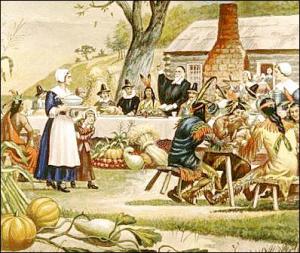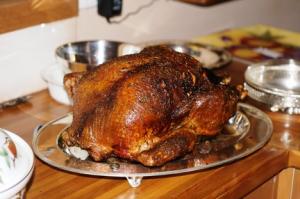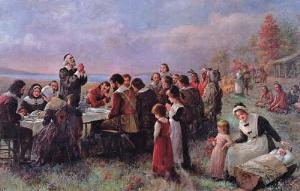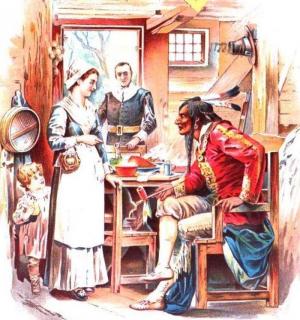
Thanksgiving is the oldest American holiday, rooted in the origins of our country. In 1621, the Plymouth colonists shared a harvest celebration meal with the Wampanoag Indians, establishing an informal, annual tradition among the Puritan settlers of giving thanks for their blessings and bounty.
Today, we recognize this first feast as the precedent for our Thanksgiving holiday, but at the time, it was in keeping with a long ethnic tradition of harvest celebrations held by Native Americans throughout the land, long before the European settlers arrived. In 1863, President Abraham Lincoln formalized the holiday, declaring the final Thursday in November as a national day of thanksgiving. Congress proclaimed that the fourth Thursday in November was Thanksgiving Day, making it an official, national holiday in 1941.
Although football games and parades have become mainstays of the holiday, a bountiful feast, shared with family and friends, remains the focal point of the day; the centerpiece of that feast is the turkey. In a survey conducted by the National Turkey Federation, nearly 88 percent of Americans said they eat turkey at Thanksgiving. How did turkey become such an iconic symbol of the holiday? Although there are no definitive accounts of exactly what the Pilgrims and their Native American friends served at that first Thanksgiving, it is likely they feasted on wild game, possibly turkey, but also goose, duck, swan and venison. Over time, turkey was served on the holiday because it was fresh, affordable, and large enough to feed a crowd.
 A traditional Thanksgiving menu includes turkey, mashed potatoes, gravy, stuffing, sweet potatoes, cranberry sauce, green beans and a pumpkin or pecan pie to finish it all off. However, the holiday is also a celebration of family, and as such, the meal has evolved to include dishes that are a part of each family’s personal history.
A traditional Thanksgiving menu includes turkey, mashed potatoes, gravy, stuffing, sweet potatoes, cranberry sauce, green beans and a pumpkin or pecan pie to finish it all off. However, the holiday is also a celebration of family, and as such, the meal has evolved to include dishes that are a part of each family’s personal history.
Senia Acosta, born and raised in Honduras, marinates her Thanksgiving turkey in coke and beer, a traditional method to prepare poultry in Honduras. Tamales also have a prominent place on her table. “In Honduras, we make tamales for special occasions, so I prepare them for Thanksgiving,” says Acosta. “Tamales are hard to make, so it involves everyone, the kids, grandmother, everyone helps. We make a big batch of tamales, and then everyone takes them home to share with their family.”
Acosta’s husband is from Mexico, her sister-in-law is from the Dominican Republic, and they each prepare traditional dishes from those countries to serve at the meal. “It’s one of the wonderful things about the holiday, everyone shares their food and their culture with one another,” says Acosta.
Maria Ellis grew up in Milwaukee, Wisconsin, the daughter of an Italian father and Greek mother. Their Thanksgiving meal was a mixture of her parent’s culinary heritage. “Dad always made eggplant parmesan and my mother prepared a traditional Greek meal of leg of lamb with potatoes. My mom would always make a turkey too, but it was always this poor little thing, set off to the side.”
As a teenager, Ellis wanted to embrace the “normal” Thanksgiving traditions, so one year, when her mother was away, she prepared what she considered a traditional Thanksgiving meal of turkey, mashed potatoes, stuffing and broccoli. No Greek food was served. “Everyone in my family thought it was terrible. It just wasn’t what they were used to.” The next year, they returned to her mother’s cooking.
 In ancient harvest festivals, people usually celebrated with games and sports, so we could argue that the Thanksgiving football tradition has very deep roots. Football has been a part of the holiday since 1876, when the Intercollegiate Football Association held its championship on Thanksgiving Day. Within a decade, this annual game, usually played between Princeton and Yale, became the premier athletic event in the nation, drawing crowds of 40,000 people.
In ancient harvest festivals, people usually celebrated with games and sports, so we could argue that the Thanksgiving football tradition has very deep roots. Football has been a part of the holiday since 1876, when the Intercollegiate Football Association held its championship on Thanksgiving Day. Within a decade, this annual game, usually played between Princeton and Yale, became the premier athletic event in the nation, drawing crowds of 40,000 people.
In 1934, NBC radio network broadcast the first national Thanksgiving football game between the Detroit Lions and the Chicago Bears on 94 stations throughout the country. The Detroit Lions have played a Thanksgiving Day game every year since then, with a brief interruption during World War II. The first time the games appeared on television was in 1956. In 1966, the Dallas Cowboys joined the Lions as the feature game on the holiday, a tradition that continues today.
Over 30 million people tuned into an NFL game last year on Thanksgiving Day. Before the advent of television, many Americans went to local stadiums to see the high school or college game. Powell Moore, who grew up in Milledgeville, GA, remembers playing in the annual game as a student at Georgia Military College in the 1950s. “People didn’t watch football on television then. The whole town would come out to watch us play our game in the afternoon, then return to their homes for their traditional dinner that night.”
The Macy’s Thanksgiving Day Parade originated in 1924, to signify the launch of the Christmas shopping season. It is a tradition that has grown throughout the years to include Broadway performers, popular musical acts, high school marching bands and enormous helium balloons, many of which feature well-known cartoon characters like Mickey Mouse and Snoopy. Over 3 million spectators line the 2 ½ mile parade route through the streets of Manhattan, and another 44 million people watch it on television.
Above all, Thanksgiving is a time when Americans join to give thanks for their blessings through prayer and fellowship. At Acosta’s church, La Fe’ en Jesucristo in Kansas City, KS, people throughout the community, especially those in need, are invited to join church members for a thanksgiving prayer session and meal. At the end of the meal, everyone is encouraged to offer their prayer of thanks. Thanksgiving has become one of the most meaningful holidays to Acosta and other members of her church, many of whom are recent immigrants. “We all chose to come to live in the United States and we are very grateful for the lives we live here,” says Acosta.
Community service has become a holiday tradition for those families who, in taking stock of their blessings on Thanksgiving, feel compelled to reach out to those in need. For the last 20 years, Christopher Martins Restaurant in New Haven, CT has served a full Thanksgiving dinner to any homeless people or working poor who need it. The meal, served in an elegant restaurant, where formally dressed volunteer wait staff wait on the diners.
 Elizabeth Walsh, and her husband, Ed, have volunteered at the event for the past decade with a very dedicated group of people that return year after year to help. “Once you get a family involved, they want to come back every year,” says Walsh. Most families spend a few hours on Thanksgiving Day serving others before they return to their own homes for a Thanksgiving meal. “You see how grateful people are for the food and the donations of clothing that Christopher Martins collects and distributes to them,” says Walsh, “And when you return to your own home, you thank God for all that you have.”
Elizabeth Walsh, and her husband, Ed, have volunteered at the event for the past decade with a very dedicated group of people that return year after year to help. “Once you get a family involved, they want to come back every year,” says Walsh. Most families spend a few hours on Thanksgiving Day serving others before they return to their own homes for a Thanksgiving meal. “You see how grateful people are for the food and the donations of clothing that Christopher Martins collects and distributes to them,” says Walsh, “And when you return to your own home, you thank God for all that you have.”
The legacy of the first Thanksgiving has influenced many of our holiday traditions, shared across the country. However, just as every family has its own unique character and ethnic heritage, so our Thanksgiving festivities include deeply personal celebrations of family and individual expressions of gratitude, making Thanksgiving one of the most cherished American holidays.
